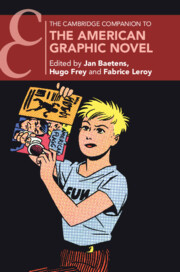Book contents
- The Cambridge Companion to the American Graphic Novel
- The Cambridge Companion to the American Graphic Novel
- Copyright page
- Contents
- Figures
- Contributors
- Editors’ Acknowledgments
- Introduction
- Part I History and Genre
- Part II Graphic Novels and the Quest for an American Diversity
- 10 Expressions of Jewishness alongside Grief in American Graphic Novels
- 11 Black Looking and Looking Black
- 12 African American New History-Writing in Graphic Narratives
- 13 Coming to America, “Land of the Free”
- 14 Spatiotemporal Projections
- 15 Queer Graphic Novels
- 16 American Women’s Lives in Graphic Novels
- Index
- Cambridge Companions To …
- References
12 - African American New History-Writing in Graphic Narratives
from Part II - Graphic Novels and the Quest for an American Diversity
Published online by Cambridge University Press: 10 January 2024
- The Cambridge Companion to the American Graphic Novel
- The Cambridge Companion to the American Graphic Novel
- Copyright page
- Contents
- Figures
- Contributors
- Editors’ Acknowledgments
- Introduction
- Part I History and Genre
- Part II Graphic Novels and the Quest for an American Diversity
- 10 Expressions of Jewishness alongside Grief in American Graphic Novels
- 11 Black Looking and Looking Black
- 12 African American New History-Writing in Graphic Narratives
- 13 Coming to America, “Land of the Free”
- 14 Spatiotemporal Projections
- 15 Queer Graphic Novels
- 16 American Women’s Lives in Graphic Novels
- Index
- Cambridge Companions To …
- References
Summary
Many Black intellectuals and artists have called for a counter-historiography that would redress the silencing of Black voices and the inadequate representation of Black experiences in earlier comics. This chapter identifies three categories of graphic historiographies, each with thematic and formal recurrences: those that propose a frontal look at the context of enslavement, from the horrors of the Middle Passage to the violence of the plantation world; those focusing on the political and social struggles of Black communities after the Civil War, from the Jim Crow era and the courageous actions of Civil Rights leaders to twenty-first-century police brutality; and, finally, those that imagine new Black futures in the mode of speculative fiction, while metaphorically referencing past forms of exploitation and repression. The chapter studies the specific devices of several of these works, including the use of temporal shifts in the graphic adaptation of Octavia Butler’s Kindred, the reliance on oral history and photo-based illustrations in John Lewis’s Run, Book One, the depiction of Black women’s subordination in Shirlene Obuobi’s ShirlyWhirlMD webcomic, and the futuristic metaphors of slavery and capitalism in Roxane Gay’s The Sacrifice of Darkness.
Keywords
- Type
- Chapter
- Information
- The Cambridge Companion to the American Graphic Novel , pp. 210 - 225Publisher: Cambridge University PressPrint publication year: 2023

